
All Saints, Old Byland
The Church
How old is this church? Much of the stone work is early Norman in style. If you go out into the churchyard and look up at the east wall of the nave, above the roof of the chancel, there you will see, embedded into the stonework, the old coping stones of an earlier, lower roof. This must have belonged to a church predating the Norman period. Judging from where that roof comes down, the south wall of the chancel and the north wall of the nave both in fact belonged to the original Saxon church. The primitive arch over the blocked-off priest’s door into the chancel also looks Saxon.
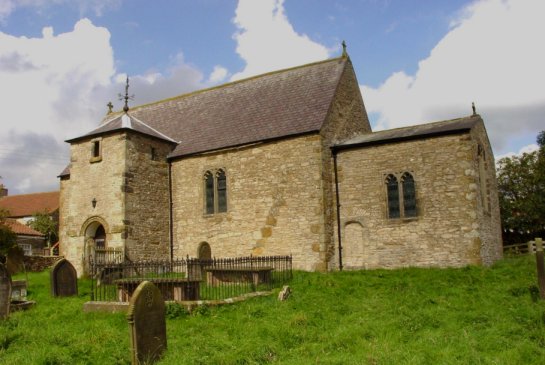
All Saints Church
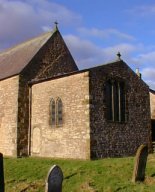
The old roofline
The First Rebuilding
Following the Norman conquest the whole area was completely devastated by William the Conqueror’s army. In 1086 the Domesday Book records only two surviving settlements in the whole of upper Ryedale; Helmsley and Old Byland. It is recorded that here there was "a priest and a wooden church" – evidently the original stone building had collapsed.
However, we must suppose that it was rebuilt very soon afterwards. The evidence for this is the carvings; the human heads with ram's horns on the chancel arch, and the winged horses on the porch. The star motif next to the horses is an especially good indicator of early Norman work. In the Saxon church the nave walls would have been exactly aligned with the chancel walls; but it looks very much as though the south nave wall was lying in ruins, and it was simpler to build the new wall outside it.
As for the winged horses: this is the a design traditionally associated with the cult of St. Oswald, the 7th Century Anglo-Saxon King of Northumbria. At a time when the Normans had just overthrown the Anglo-Saxon monarchy, it may well be that the harbouring of this particular saint was actually a little gesture of political defiance on the part of the villagers – directed against the local Norman overlords down at Helmsley castle!
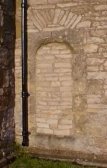
The Saxon arch over
the priest's door
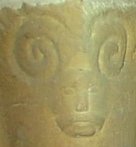
A human head with
ram's horns carving

The winged horse & star carvings
The Byland Monks
Then came the Byland monks. Originally they had been based at Calder, in Cumbria, but in the mid 1130s marauding Scots drove them from there. They fled, with all their worldly goods piled up in a single wagon, pulled by eight oxen.
First they went to Furness Abbey. But the Furness monks turned them away. And so, moving at the oxen's pace, for a whole year they went wandering east across England, looking for a new patron to give them land – until at last they struck lucky in Thirsk, where they met the good lady Gundreda.
She gave them land: a temporary billet at the foot of Sutton Bank; and subsequently, in 1143, at Tylas, a mile or so up river from Rievaulx.
There was already a little settlement there, but the peasants were ordered out -and resettled here in Old Byland. This was probably when the village acquired its present shape. And the monks also seem to have supplied the church with its font. Not that they stayed long. Tylas was too close to Rievaulx: the Rievaulx Abbey bells disturbed the Tylas monks, and the Tylas bells disturbed the Rievaulx monks. So off they went again, first to Stocking, near Kilburn - and then to Byland where they finally built the abbey whose ruins remain today, the largest in all England.
Nevertheless, throughout the Middle Ages the village remained in their possession.
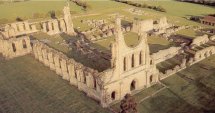
Byland Abbey
Later Works
The church was partly rebuilt again in the 14th or 15th century. (Perhaps it was one of those burnt down by Robert the Bruce's invading Scots army?) At this point it acquired a new north chancel wall, again outside the line of the old one; also new windows in the south walls; a new tiled sanctuary floor; and a new roof. The present porch is an 18th century construction, largely reusing the stones that were there before. The remaining windows in their present form date back to 1909. And then in the 1970s, when the roof began to give way, the church was briefly abandoned - before yet a further restoration in 1981.
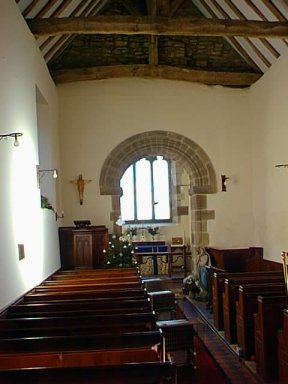
The interior of All Saints
In the chancel is a rough stone basin. During the 19th century it is recorded as standing on the village green. It may date back to the Viking period, or even be Romano-British. The 18th century wooden cover over it used to belong to the font.
Embedded in the outer wall of the porch on the eastern side is an ancient Saxon sundial.
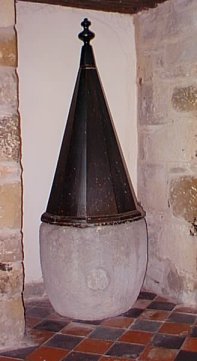
The stone basin & font cover
The Great Sale of 1922
The main event in the life of Old Byland in the 20th century was when almost the whole village was auctioned off - on June 7th, 1922, at the Royal Station Hotel, York. Previously it had been owned by the Wombwells, of Newburgh Priory, but debts had accrued. So it was offered for sale: 9 freehold farms, 11 smallholdings, an inn, a school and a blacksmith's shop, "altogether forming one of the most fascinating and beautiful Estates in the North Riding of Yorkshire ..."
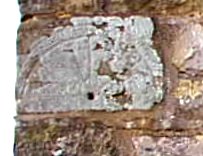
The Saxon sundial
Upper Ryedale Parish
In 1979 the church - previously united with Hawnby - was incorporated into the newly created Upper Ryedale parish, which now includes Scawton, Cold Kirby and Bilsdale Midcable. Although covering a large area, the total parish today has a population of not much more than 450. But still we continue to hold regular services here, at least once a month. (Moreover, thanks to modern technology, we also have Lincoln Cathedral Choir along to lead the singing...). Visitors are very welcome.
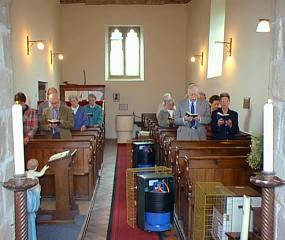
Sunday worship in All Saints
Home Page The Five Churches The Poetry Church Service Times About the Parish
Who's Who Tracing Your Ancestors Local History Hawnby Dreamers Useful Links